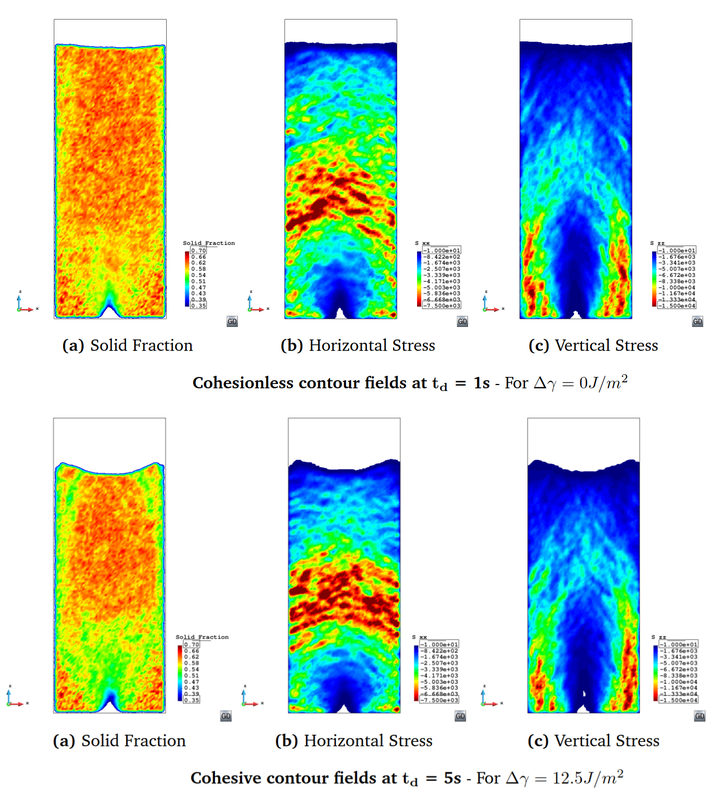Discrete Element Modelling of Iron Ore Fines to Include the Effects of Moisture and Fines
 DEM Silo Discharge
DEM Silo Discharge
Abstract
Across industry the majority of raw materials handled are particulate in nature, ranging in size and properties from aggregates to powders. The stress regimes experienced by the granular solids vary and the exhibited bulk behaviours can be complex and unexpected. The prevalence of granular solids makes them an area of interest for industry and researchers alike as many challenges still remain, such as dealing with complex cohesive behaviour in materials, which often gives rise to handling difficulties.
Storage and transportation are an important part of the process chain for industries where particulate solids are commonplace. Failure to properly account for the cohesive nature of a particulate solid can be costly as it can easily lead to blockages in a silo such as ratholing or arching near the outlet during discharge. The cohesive strength of a bulk material depends on the consolidation stress it has experienced. As a result, the stress history in the material leading up to a handling scenario needs to be considered when evaluating its handling behaviour.
The Discrete Element Method (DEM) has been extensively used to simulate the behaviour of granular materials, however the majority of the focus has been on non-cohesive systems. For cohesive solids, it is crucial that the stress history dependent behaviour is adequately captured. Many of the contact models commonly used in DEM simulations to simulate cohesive granular materials such as the JKR model or liquid bridge models are elastic in nature and may not capture the stress history dependent behaviour observed in cohesive particulate solids.
A comprehensive study on the effect of cohesion arising from the addition of moisture on the behaviour of two types of LKAB iron ore fines (KPBO and KPRS) has been carried out. The addition of moisture to the sample has been found to have a significant effect on both kinds of fines. KPRS fines were found to have a much higher unconfined strength and flow function at higher moisture contents, and also show a greater increase in cohesion with the addition of moisture, while at moisture contents of less than 2% the KPBO fines demonstrate higher unconfined yield strength. The KPBO fines were also found to achieve a significantly looser initial packing at much lower moisture content when compared to the KPRS fines. The lateral pressure ratio has also been evaluated.
In this study a mesoscopic adhesive contact model that accounts for contact plasticity and stress history dependency in the bulk solid, the Edinburgh Elasto-Plastic Adhesion (EEPA) mode, has been presented and mathematically verified. A parametric study of the DEM contact model parameters was conducted to gain a deeper understating of the effect of input parameters on the simulated cohesive bulk behaviour.
The EEPA contact model has been used to predict an experimental flow function of KPRS iron ore fines. The contact model has demonstrated the ability to capture the stress history dependent behaviour that exists in cohesive granular solids. The DEM simulations provide a very close match to the experimental flow functions, with the predicted unconfined strengths found to be within the standard deviations of the experimental results. Investigations into the failure mode predicted by the DEM simulations show that the samples are failing from the development of shear planes similar to those observed experimentally.
The effect of increasing levels of adhesion has been explored for a flat bottomed silo where the level of adhesion has been varied. The DEM simulations were found to capture the major phenomena occurring in silo discharge including the various flow zones associated with a flat bottomed silo. Funnel flow, the effective transition and mass flow which are associated with a mixed flow pattern were observed in the model silo. The location of the effective transition height was identified: above this was mass flow. The velocity determined from the discharge rate was found to be in excellent agreement with the velocity profiles found in the zones of mass flow. A high velocity core flow zone was observed above the outlet where velocities were greater than 1.25 times the mass flow velocity, Vsub>MF.
The level of adhesion in the silo was found to affect the discharge rate - a reduced flow rate was found until the eventual blockage of the silo at a high level of adhesion was found. As the level of adhesion increased the probability of arching also increased, and the formation of intermittent arching behaviour was noted in the cases with higher levels of adhesion in the system. The development of both temporary and permanent cohesive arches over the silo outlet were also observed with stopped flow from the silo.